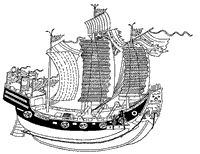| Discovering Asia's
ceramic development |
The indigenous ceramic trade
 The
Chinese and Arabs shipped ceramics across the South China Sea as early as the
9th century. Chinese oceangoing 'junks' were designed differently from Southeast
Asian vessels. Chinese ships carried two or more masts, and were commonly around
thirty metres in length. They were built from temperate-climate wood, joined
by iron nails. Southeast Asian ships were built from tropical hardwood and were
joined by wooden dowels. Portuguese arrivals in Malacca in 1509 reported that
Malay ships were very large and capable of navigating as far as east Africa.
The
Chinese and Arabs shipped ceramics across the South China Sea as early as the
9th century. Chinese oceangoing 'junks' were designed differently from Southeast
Asian vessels. Chinese ships carried two or more masts, and were commonly around
thirty metres in length. They were built from temperate-climate wood, joined
by iron nails. Southeast Asian ships were built from tropical hardwood and were
joined by wooden dowels. Portuguese arrivals in Malacca in 1509 reported that
Malay ships were very large and capable of navigating as far as east Africa.
By the 12th century, enormous quantities of Chinese green-glazed ceramics (celadon)
were exported to the Middle East, India and throughout Southeast Asia. At the
beginning of the Ming dynasty (1368-1644), when the Chinese emperor prohibited
overseas trade, Chinese potters moved to Thailand and resumed production.
 Between
the 14th and 16th centuries, Southeast Asian countries made and shipped the
largest volumes of ceramics traded on the South China Sea. The earliest
Southeast Asian exporters were Thailand and Vietnam. They traded frequently
with Japan, the Philippines, Borneo and the Indonesian archipelago.
Between
the 14th and 16th centuries, Southeast Asian countries made and shipped the
largest volumes of ceramics traded on the South China Sea. The earliest
Southeast Asian exporters were Thailand and Vietnam. They traded frequently
with Japan, the Philippines, Borneo and the Indonesian archipelago.
Asian markets predominated, despite some trade with the Middle East, until
the early 17th century when Europeans started to ship large volumes of Chinese
blue-and-white porcelain to Europe.
 The
Chinese and Arabs shipped ceramics across the South China Sea as early as the
9th century. Chinese oceangoing 'junks' were designed differently from Southeast
Asian vessels. Chinese ships carried two or more masts, and were commonly around
thirty metres in length. They were built from temperate-climate wood, joined
by iron nails. Southeast Asian ships were built from tropical hardwood and were
joined by wooden dowels. Portuguese arrivals in Malacca in 1509 reported that
Malay ships were very large and capable of navigating as far as east Africa.
The
Chinese and Arabs shipped ceramics across the South China Sea as early as the
9th century. Chinese oceangoing 'junks' were designed differently from Southeast
Asian vessels. Chinese ships carried two or more masts, and were commonly around
thirty metres in length. They were built from temperate-climate wood, joined
by iron nails. Southeast Asian ships were built from tropical hardwood and were
joined by wooden dowels. Portuguese arrivals in Malacca in 1509 reported that
Malay ships were very large and capable of navigating as far as east Africa.